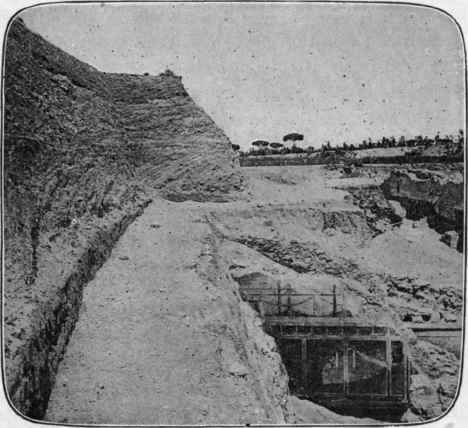Volcanic Eruptions
Description
This section is from the book "An Introduction To Geology", by William B. Scott. Also available from Amazon: An Introduction to Geology.
Volcanic Eruptions
The phenomena displayed by different volcanoes, or even by the same volcano at different times, vary greatly. It often seems difficult to believe that similar forces are involved, and that the divergences are due merely to different circumstances attending the outbreak. A careful comparison, however, of the varying phenomena brings to light a fundamental likeness in them all. Some vents, like Stromboli in the Mediterranean, are in an almost continual state of eruption of a quiet kind; others, like Vesuvius, have long periods of dormancy, broken by eruptions of terrible violence. In a general way, it may be said that the longer the period of quiet, the more violent and long-continued will the subsequent eruption be, while weak eruptions and those of short duration recur at brief intervals.
As one extreme of the various forms of volcanic activity should be regarded the explosive type, in which little or no lava is produced and, in some cases, even the finely shattered fragments of lava, the so-called volcanic ash, are absent. An instructive example of this kind is afforded by the eruption of the Japanese volcano Shirane in 1882, which consisted of a single tremendous explosion of steam, hurling a vast column of rock into the air, but without the emission of lava or ashes. Another eruption of the same kind was that of Bandai San, also a Japanese volcano, in 1888; a single terrific steam explosion blew away the greater part of the mountain, which was more than 2000 feet high, likewise without the formation of ash or lava.
The first recorded eruption of Vesuvius, which occurred in 79 a.d. and is described in two letters written to Tacitus by the younger Pliny, was of the explosive type, but was much more prolonged than those of the Japanese vents above-mentioned and was accompanied by the production of immense volumes of ashes and larger fragments. In this frightful paroxysm little or no molten lava was ejected, and so enormous was the quantity of ashes that at Misenum, across the bay of Naples, the sun was darkened, as Pliny reports, "not as on a moonless cloudy night, but as when the light is extinguished in a closed room ... In order not to be covered by the falling ashes and crushed by their weight, it was often necessary to rise and shake them off." Herculaneum was overwhelmed with floods of ashes mixed with water, while Pompeii was completely buried in dry ashes and small fragments.
The explosive type of eruption is exhibited in its extreme form by several of the East Indian volcanoes, and preeminently by Kra-katoa, the eruption of which in 1883 was the most frightful ever recorded. This volcanic island, situated in the Strait of Sunda, was little known, except that it had been in eruption in 1680. As the island was uninhabited, the earliest stages of the outburst were not observed, but on May 20 a great cloud of steam was seen over the vent. The catastrophe occurred in August, when, besides the fearful devastation caused by the disturbances of the sea on the coasts of Sumatra and Java, the island itself was almost annihilated. Hardly one-third of its original surface was left above water, and where formerly was land are now depths of 100 to 150 fathoms of water. The force of the explosion produced waves in the atmosphere which were propagated around the whole earth, and the first one was observed in Berlin ten hours after the explosion. The ejected materials were all fragmentary and of an incredible volume; ashes were distributed over an area of 300,000 square miles, the greater part falling within a radius of eight miles around the island; stretches of water that had had an average depth of 117 feet were so filled up as to be no longer navigable.
Enormous masses of pumice floated upon the sea and stopped navigation except for the most powerful steamers. Even more remarkable is the fact that the finest dust, which was hurled into the upper atmosphere, remained suspended in the air for many months and was gradually diffused over the world. The wonderful, flaming-red sunsets which characterized the autumn and winter of 1883-1884, have been very generally ascribed to the refractive effects of the impalpably fine Krakatoa dust.

Fig. 10. - Pompeii, showing depth of volcanic accumulations. (Photograph by McAllister).

Fig. 11. - Profiles of Krakatoa. The full curved line is the present condition, the dotted line the condition before the eruption of 1883, while the horizontal line is that of sea-level. (Judd).
These tremendous explosions, even when they do not tear out one whole side of the mountain as in the case of Krakatoa, may blow off the top and thus leave a great crater ring many miles in circumference, within which subsequent eruptions may build up a new cone. When the volcanic activity dies out, the ring may be filled with water, forming a circular lake. Crater rings may also be formed in another way, illustrated by Crater Lake in Oregon. The glacial markings on the outer side of the mountain prove that the latter must once have been much higher than at present. On the other hand, the surrounding country displays no such quantity of fragments as would have been formed, had the top been blown off by an explosion. In this case, the upper portion of the cone was probably engulfed in the crater and perhaps remelted.
Continue to:


